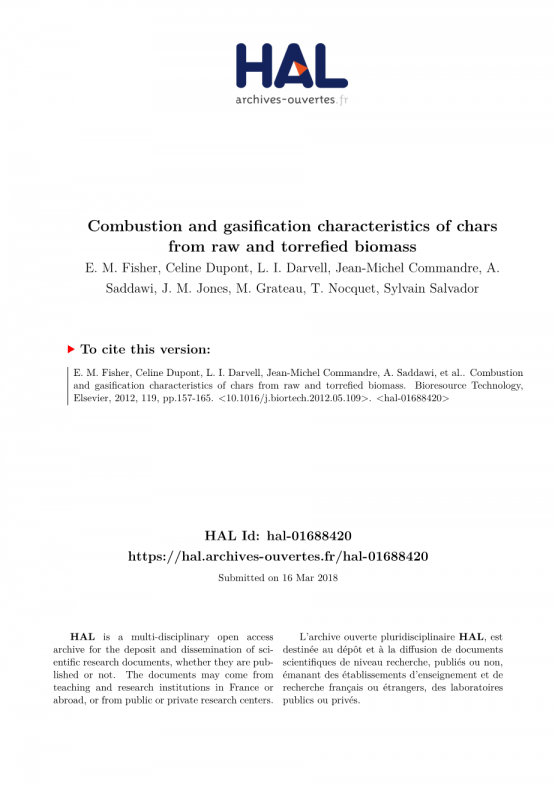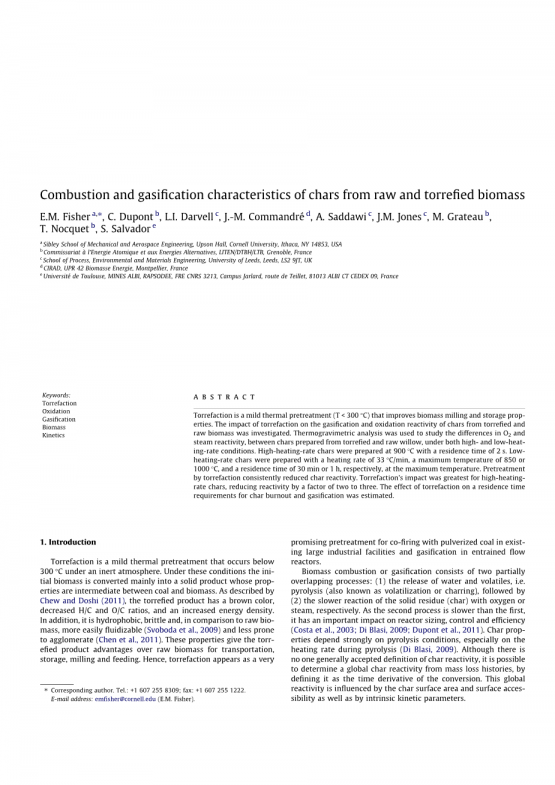Combustion and gasification characteristics of chars from raw and torrefied biomass
原料和烘焙生物质炭的燃烧和气化特性
Keywords: Torrefaction Oxidation Gasification Biomass Kinetics
关键词:烘焙,氧化,气化,生物质,动力学
Abstract
Torrefaction is a mild thermal pretreatment (T lt; 300 ℃) that improves biomass milling and storage properties. The impact of torrefaction on the gasification and oxidation reactivity of chars from torrefied and raw biomass was investigated. Thermogravimetric analysis was used to study the differences in O2 and steam reactivity, between chars prepared from torrefied and raw willow, under both high- and low-heating-rate conditions. High-heating-rate chars were prepared at 900 ℃ with a residence time of 2 s. Low-heating-rate chars were prepared with a heating rate of 33 ℃/min, a maximum temperature of 850 or 1000 ℃, and a residence time of 30 min or 1 h, respectively, at the maximum temperature. Pretreatment by torrefaction consistently reduced char reactivity. Torrefactionrsquo;s impact was greatest for high-heating-rate chars, reducing reactivity by a factor of two to three. The effect of torrefaction on a residence time requirements for char burnout and gasification was estimated.
摘要
烘焙是一种温和的热预处理(T lt;300℃),可改善生物质的研磨和储存特性。研究了烘焙对烘焙和生物质生物炭的气化和氧化反应活性的影响。热重分析用于研究在高加热和低加热速率条件下从烘焙和原料制备的炭之间的O 2和蒸汽反应活性的差异。在900℃下制备高加热速率的焦炭,停留时间为2秒。在最高温度下制备低加热速率炭,加热速率为33℃/ min,最高温度为850或1000℃,停留时间分别为30分钟或1小时。通过烘焙预处理一致地降低了焦炭反应活性。烘焙对于高加热率焦炭的影响最大,将其反应活性降低了两到三倍。估算了烘焙对焦烧和气化的停留时间要求的影响。
1. Introduction
1.简介
Torrefaction is a mild thermal pretreatment that occurs below 300 ℃ under an inert atmosphere. Under these conditions the initial biomass is converted mainly into a solid product whose properties are intermediate between coal and biomass. As described by Chew and Doshi (2011), the torrefied product has a brown color, decreased H/C and O/C ratios, and an increased energy density. In addition, it is hydrophobic, brittle and, in comparison to raw bio-mass, more easily fluidizable (Svoboda et al., 2009) and less prone to agglomerate (Chen et al., 2011). These properties give the torrefied product advantages over raw biomass for transportation, storage, milling and feeding. Hence, torrefaction appears as a very promising pretreatment for co-firing with pulverized coal in existing large industrial facilities and gasification in entrained flow reactors.
烘焙是一种温和的热预处理,发生在300℃以下惰性气氛中。 在这些条件下,初始生物质主要转化为固体产物,其性质介于煤和生物质之间。 如Chew和Doshi所述,烘焙产品呈棕色,降低的H / C和O / C比,以及增加的能量密度。 此外,它具有疏水性,脆性,与原始生物质相比,更容易流化、不易结块。 这些特性赋予烘焙产品优于原料生物质用于运输,储存,研磨和进料的优势。 因此,烘焙作为非常有希望的预处理用于在现有大型工业设施中与粉煤共烧并在夹带流反应器中气化。
Biomass combustion or gasification consists of two partially overlapping processes: (1) the release of water and volatiles, i.e. pyrolysis (also known as volatilization or charring), followed by (2) the slower reaction of the solid residue (char) with oxygen or steam, respectively. As the second process is slower than the first, it has an important impact on reactor sizing, control and efficiency (Costa et al., 2003; Di Blasi, 2009; Dupont et al., 2011). Char properties depend strongly on pyrolysis conditions, especially on the heating rate during pyrolysis (Di Blasi, 2009). Although there is no one generally accepted definition of char reactivity, it is possible to determine a global char reactivity from mass loss histories, by defining it as the time derivative of the conversion. This global reactivity is influenced by the char surface area and surface accessibility as well as by intrinsic kinetic parameters.
生物质燃烧或气化由两个部分重叠的过程组成:(1)水和挥发物的释放,即热解(也称为挥发或炭化)(2)固体残余物(炭)与氧气或蒸汽的慢反应。 由于第二个过程比第一个过程慢,因此反应堆的尺寸,控制和效率具有重要影响。 炭的性质很大程度上取决于热解条件,特别是热解过程中的加热速率。 虽然没有一个普遍接受的炭反应活性定义,但通过将其定义为转换的时间导数,可以从质量损失历史中确定全局炭反应活性。这种全局反应活性受炭的表面积和表面可达性以及内在动力学参数的影响。
Two key attributes of torrefied biomass, in comparison to raw biomass, are relevant to char morphology and thus to char reactivity: the reduced amount of volatiles to be released during pyrolysis, and the different distribution of particle sizes produced during milling. Both of these differences are expected to be most influential under fast pyrolysis conditions, as described below.
与原料生物质相比,烘焙生物质的两个关键属性与炭形态相关,因此也与炭反应活性相关:热解期间释放的挥发物减少,以及在研磨期间产生的粒度的不同分布。 如下所述,这两种差异在快速热解条件下的影响最大
When raw biomass is rapidly pyrolyzed, the resulting rapid re-lease of volatiles deforms biomass structures and typically leads to higher macropore surface areas and thus to higher reactivities (Di Blasi, 2009). It appears that torrefaction, which shifts volatiles re-lease to the low-heating-rate torrefaction process, could reduce this effect, thus lowering the reactivity of high-heating-rate chars.
当原始生物质快速热解时,挥发物的快速释放使生物质结构变形并且通常导致更大的孔隙表面积并因此导致更高的反应活性。研究表明烘焙将挥发物再转移到低加热速率的烘焙过程,可以减少这种影响,从而降低高加热速率炭的反应活性。
The typical distribution of particle sizes present in torrefied vs. raw biomass may also have an important effect. Pulverized woody biomass particles are typically 300 mu;m or even larger in their small dimension, while pulverized coal particles are closer to 50mu;m (Tillman, 2000; Skeen et al., 2010). While industrial-scale size distribution data are not available for torrefied materials, it appears that pulverized torrefied biomass has a size distribution more comparable to that of coal than that of raw biomass (Bridgeman et al., 2010; Repellin et al., 2010). Transport limitations during heating are reduced for smaller particles, resulting in a higher effective heating rate. Although research in this area has been limited, initial particle size has been observed to have an impact on morphology of biomass chars (Avila et al., 2011) and on reactivity of coal chars (Zhu et al., 2008). Experimental particle size distributions in the present study (given below) reflect the anticipated differences between torrefied and raw biomass that will occur in full-scale devices.
烘焙与原料中存在的颗粒尺寸的典型分布也可具有重要影响。粉碎的木质生物质颗粒的小尺寸通常为300 mu;m或甚至更大,而粉煤颗粒接近50mu;m。虽然没有工业规模的烘焙物料粒度分布数据


英语原文共 10 页
您可能感兴趣的文章
- 播撒生物炭促进鸟粪石形成,但加速重金属积累外文翻译资料
- 钢铁工业余热有机朗肯发电的能量及炯分析外文翻译资料
- 深度共晶溶剂微波辅助处理木质素-碳水化合物复合 物的高效裂解及超快提取木质素低聚物外文翻译资料
- 功能化杯状芳烃离子团族[4]的合成、晶体结构及竞争结合性能外文翻译资料
- 面向高能量密度柔性超级电容器的无纺布用黑磷杂化微纤维的微流控纺丝结构外文翻译资料
- 活性炭对水溶液中氨的吸附外文翻译资料
- 制备可控海胆状NiCo2S4微球协同硫掺杂石墨烯作为高性能 二次锌空气电池的双功能催化剂外文翻译资料
- 钛酸盐材料对重金属离子的吸附外文翻译资料
- CO2敏感催化剂的合成与表征温度响应催化聚离子液体微凝胶外文翻译资料
- 温度响应微凝胶薄膜在湿环境中作为可逆二氧化碳吸收剂外文翻译资料


